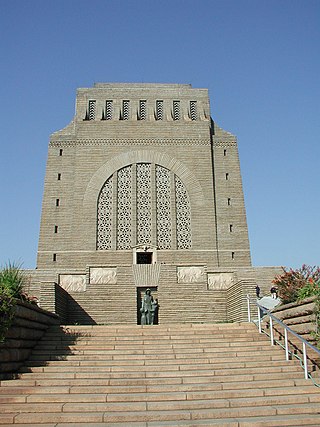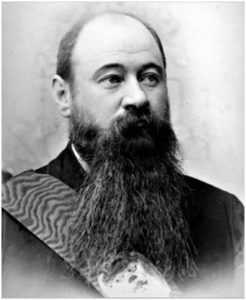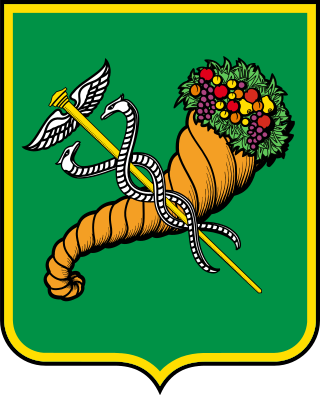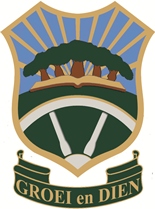
The coat of arms of South Africa is the main heraldic insignia of South Africa. The present coat of arms was introduced on Freedom Day, 27 April 2000, and was designed by Iaan Bekker. It replaced the earlier national arms, which had been in use since 1910. The motto is written in the extinct ǀXam, member of the Khoisan languages, and translates literally to "diverse people unite". The previous motto, in Latin, was Ex Unitate Vires, translated as "From unity, strength".

The Great Trek was a northward migration of Dutch-speaking settlers who travelled by wagon trains from the Cape Colony into the interior of modern South Africa from 1836 onwards, seeking to live beyond the Cape's British colonial administration. The Great Trek resulted from the culmination of tensions between rural descendants of the Cape's original European settlers, known collectively as Boers, and the British Empire. in Cape Town. Boers who took part in the Great Trek identified themselves as voortrekkers, meaning "pioneers", "pathfinders" in Dutch and Afrikaans.

Sandton is a financial, commercial and residential area, located in the northern part of the City of Johannesburg Metropolitan Municipality. Formerly an independent municipality, Sandton's name came from the combination of two of its suburbs, Sandown and Bryanston.

The Voortrekker Monument is located just south of Pretoria in South Africa. The granite structure is located on a hilltop, and was raised to commemorate the Voortrekkers who left the Cape Colony between 1835 and 1854. It was designed by the architect Gerard Moerdijk.
The Afrikaner Broederbond (AB) or simply the Broederbond was an exclusively Afrikaner Calvinist and male secret society in South Africa dedicated to the advancement of the Afrikaner people. It was founded by H. J. Klopper, H. W. van der Merwe, D. H. C. du Plessis and the Rev. Jozua Naudé in 1918 as Jong Zuid Afrika until 1920, when it was renamed the Broederbond. Its influence within South African political and social life came to a climax with the 1948-1994 rule of the white supremacist National Party and its policy of apartheid, which was largely developed and implemented by Broederbond members. Between 1948 and 1994, many prominent figures of Afrikaner political, cultural, and religious life, including every leader of the South African government, were members of the Afrikaner Broederbond.

MartinusTheunis Steyn was a South African lawyer, politician, and statesman. He was the sixth and last president of the independent Orange Free State from 1896 to 1902.

A sun cross, solar cross, or wheel cross is a solar symbol consisting of an equilateral cross inside a circle.

Vereeniging is a city located in the south of Gauteng province, South Africa, situated where the Klip River empties into the northern loop of the Vaal River. It is also one of the constituent parts of the Vaal Triangle region and was formerly situated in the Transvaal province. The name Vereeniging is the Dutch word meaning "association".

A referendum on becoming a republic was held in South Africa on 5 October 1960. The Afrikaner-dominated right-wing National Party, which had come to power in 1948, was avowedly republican and regarded the position of Queen Elizabeth II as the South African monarch as a relic of British imperialism. The National Party government subsequently organised the referendum on whether the then Union of South Africa should become a republic. The vote, which was restricted to whites—the first such national election in the union—was narrowly approved by 52.29% of the voters. The Republic of South Africa was constituted on 31 May 1961.

The Luther rose or Luther seal is a widely recognized symbol for Lutheranism. It was the seal that was designed for Martin Luther at the behest of John Frederick of Saxony in 1530, while Luther was staying at the Coburg Fortress during the Diet of Augsburg. Lazarus Spengler, to whom Luther wrote his interpretation below, sent Luther a drawing of this seal. Luther saw it as a compendium or expression of his theology and faith, which he used to authorize his correspondence. Luther informed Philipp Melanchthon on 15 September 1530, that the Prince had personally visited him in the Coburg fortress and presented him with a signet ring, presumably displaying the seal.
Willowridge High School is a public English co-educational high school situated in the suburb of Die Wilgers in Pretoria in the Gauteng province of South Africa. The school was established in 1987.

The Panamanian coat of arms is a heraldic symbol for Panama. These arms were adopted provisionally and then definitively by the same laws that adopted the Panamanian flag.

The Day of the Vow is a religious public holiday in South Africa. It is an important day for Afrikaners, originating from the Battle of Blood River on 16 December 1838, before which about 400 Voortrekkers made a promise to God that if he rescued them out of the hands of the approximately 20,000 Zulu warriors they were facing, they would honour that day as a sabbath day in remembrance of what God did for them.

Afrikaner nationalism is a nationalistic political ideology created by Afrikaners residing in Southern Africa during the Victorian era. The ideology was developed in response to the significant events in Afrikaner history such as the Great Trek, the First and Second Boer Wars and the resulting anti-British sentiment that developed among Afrikaners and opposition to South Africa's entry into World War I.

The Coat of arms of Kharkiv is the official coat of arms of both Kharkiv city and Kharkiv Oblast.
The Beweging vir Christelik-Volkseie Onderwys is an educational organisation in South Africa that provides primary and secondary education in the Calvinist tradition and Afrikaans language. There are currently 41 directly affiliated schools throughout South Africa—mainly in the areas of the former "Boer Republics" of the Orange Free State and the Transvaal, educating approximately 2100 children.

The Afrikaans Language and Culture Association, ATKV, is a society that aims to promote the Afrikaans language and culture. The association was founded in 1930 in Cape Town. Since its inception and up to the end of Apartheid in 1994, membership was only open to members of the Afrikaner Christian community. Membership was thereafter opened to include people of all ethnicities, sharing the same values as the ATKV.

Die Hoërskool Wonderboom is a public Afrikaans medium co-educational high school situated in the suburb of Wonderboom South in Pretoria in the Gauteng province of South Africa, on the southern slopes of the Magaliesberg, The learners are known as the Wonnies

Hoërskool Voortrekker is a public Afrikaans medium co-educational high school situated in the municipality of Boksburg in the city of Ekurhuleni in the Gauteng province of South Africa. The academic school was established in 1920.

The South African Republic, which existed from 1852 to 1877, 1881 to 1902, and 1914 to 1915, used two flags: (1) the so-called 'Vierkleur' from 1857 to 1874, and again from 1875 to 1877 and 1881 to 1902, and (2) the so-called 'Burgers Flag' from 1874 to 1875. They were superseded by the flag of Transvaal. The Vierkleur was also used by the South African Republic declared in 1914 during the Maritz Rebellion, which lasted into February 1915.


















